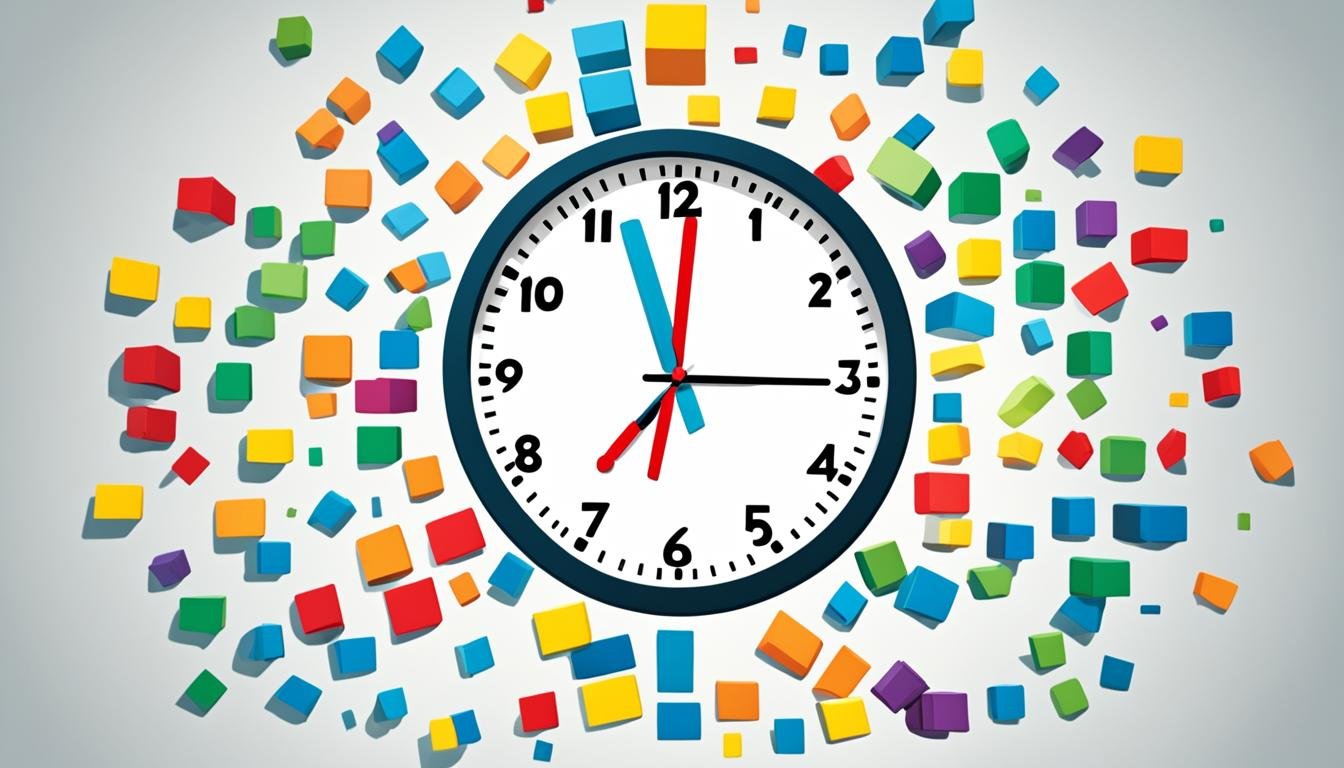Living in a world full of distractions, mastering time management is key. You need to use smart techniques and have the right mindset to make the most of your day. By setting priorities, working better, and beating procrastination, you can boost how much you get done.
Key Takeaways:
- Task prioritization is essential for effective time management
- Setting clear goals helps align your daily activities
- Utilize productivity hacks to increase efficiency
- Manage your calendar effectively to stay organized
- Prevent procrastination by implementing time blocking techniques
Define Your Priorities
Managing your time well starts with knowing what’s most important to you. It’s key to set your priorities based on your biggest goals. This way, you make sure your daily tasks help you reach those goals.
Think about what really motivates you in life. This could be growing in your job, making strong connections, or feeling fulfilled personally. Once you know these goals, you can focus your daily actions around them.
Setting priorities means knowing the value of each task. Ask yourself if a task gets you closer to your main goals. Is it essential for where you want to go? This way, you choose what to work on first based on what matters most.
Getting your priorities straight is about cutting out what doesn’t matter. It helps you spend your time on what really counts. By doing this, you boost how much you get done. You focus on moving toward your big goals every day.
Quote:
“Efficiency is doing things right; effectiveness is doing the right things.” – Peter Drucker
Use the 80/20 Rule
The 80/20 rule, known as the Pareto Principle, says 80% of results come from 20% effort. By picking tasks with the biggest impact, you boost productivity.
Use this rule to sort your tasks. Focus on ones tied to your main goals. This way, you spend time on what really matters.
“The 80/20 rule reminds us to focus on the tasks that truly matter and have the potential to make a difference. By prioritizing and directing our efforts towards these high-impact activities, we can achieve our desired outcomes more efficiently.”
Concentrating on key tasks is vital for managing time well. It helps you do more in less time. This means skipping tasks that don’t help your goals.
To use the 80/20 rule, look at your tasks. Find those important for your goals. Then, focus on them to boost your productivity.
Create a Daily Plan
Starting each day with a well-crafted daily plan can set you up for success. It helps you stay focused on your goals. Create a to-do list or schedule with your top tasks to make progress on what matters most. Here’s how to get your daily plan ready for maximum productivity:
1. Prioritize Tasks
Identify the most important tasks first. This makes it easier to get through them. Break down big tasks into smaller parts to feel less overwhelmed.
This way, you can handle the most crucial tasks first. This keeps you feeling productive all day.
2. Task Breakdown
Break complex tasks into smaller steps. Tackling each part on its own makes it less daunting. It helps you stay focused and motivated.
Checking things off as you go also gives you a sense of accomplishment.
3. Allocate Time Blocks
Set aside specific times for different activities. Make sure you have time for focused work without interruptions. Also, plan for meetings, brainstorming, and personal time.
By giving time to each activity, you make sure everything important gets done well.
4. Utilize Technology Tools
Use digital tools and apps to manage your tasks. These tools remind you and help you stay on schedule. Task management apps and calendar tools can be helpful.
Look for the ones that best suit your needs.
“A daily plan is like a roadmap that guides you towards your goals and allows you to make efficient use of your time.”
5. Review and Adjust
Check and update your daily plan regularly. This lets you change things as needed, like new priorities or surprises. Keep an eye on your progress and make tweaks to stay on course.
Having a daily plan means you face each day with purpose. It’s about focusing on tasks, setting aside time, and using tech to keep everything in line.
Leverage Time-Blocking Techniques
One of the best ways to manage your time well is through time-blocking. It means setting aside specific times for certain tasks. This boosts your focus, gets more done, and cuts out distractions. It lets you work deeply on tasks that need all your attention.
It’s important to choose which tasks need your full focus. Spend two hours each morning on these key tasks. This gives you deep, uninterrupted work time. It helps you get in the zone and achieve peak performance.
It’s vital to avoid distractions while time-blocking. Keep your phone out of reach and close unneeded computer tabs. Make sure you work in a quiet place. You can also use tools like noise-canceling headphones or apps that block social media.
Don’t forget the importance of taking breaks. Pause between your time blocks to refresh yourself. A short walk or some stretching can help clear your mind.
Let’s look at how time-blocking can improve certain tasks:
| Task | Traditional Approach | Time-Blocking Approach |
|---|---|---|
| Writing a Research Paper | Work on it now and then during the day, getting sidetracked by emails and social media. | Set aside a two-hour slot in the morning just for research and writing. By removing distractions, this focus time can make a big difference. |
| Preparing a Presentation | Deal with the presentation whenever you find time, which hampers real progress. | Devote a solid three-hour block to prepare the presentation. Silence your phone and ignore emails for this intense focus time. |
| Reviewing Reports | Look at reports off and on, often getting distracted by others or meetings. | Allocate a dedicated hour to go over reports. Tell your team that you’re focused right now. This helps in avoiding interruptions. |
Adding time-blocking to your daily routine can greatly boost how much you get done. By focusing deeply on tasks, cutting out distractions, and setting aside focused time, you can increase your productivity. This method helps you concentrate better, finish tasks more effectively, and reach your goals.

Practice the Two-Minute Rule
Time is precious and being efficient is key to being more productive. The two-minute rule is a great way to use your time wisely. It says that if a job takes two minutes or less, do it now instead of later. This stops small tasks from adding up and keeping you from more important things.
Using the two-minute rule helps stay ahead on quick tasks. Things like short emails, organizing files, or quick phone calls can be handled immediately. This stops them from becoming a big burden.
“The two-minute rule helps eliminate micro-tasks that can clutter your to-do list and hinder your focus.”
Following the two-minute rule can make you feel more accomplished. Dealing with small jobs right away creates a flow of success. This can push you to handle bigger tasks and not feel overwhelmed by the small things.
Immediate Task Completion
Completing tasks right away supports the two-minute rule’s success. By tackling these small jobs immediately, you clear your mental space for more important work. It also makes you feel good, boosting your productivity.
But not every task needs to be done right away. Choose tasks that really fit the two-minute rule and align with your goals. This approach can boost your productivity and focus.
Harness the Power of Deadlines
Realistic deadlines are key to managing your time well. They help you focus and finish on time. Setting goals that are too hard can stress you out and lower the quality of your work.
Breaking big projects into small steps with their own deadlines is a great strategy. This helps you see your progress and feel good as you check off each step. It also stops you from feeling overwhelmed because you’ve got smaller tasks to deal with.
Imagine you have to finish a big report in two weeks. Instead of aiming to do the whole thing by the due date, split it into parts. Set a deadline for each section. This way, you can concentrate on parts of the report one by one. You’re more likely to do a good job and not rush.
The Benefits of Milestone Breakdown:
- Clear Progress Tracking: Breaking projects into smaller parts helps you see how far you’ve come.
- Enhanced Focus: Working on smaller bits makes you concentrate better, which improves your work.
- Increased Motivation: Finishing each step gives you a sense of accomplishment and keeps you working towards the end.
- Opportunity for Reflection and Revision: If you finish your report early, you’ll have time to make it even better before turning it in.
Using deadlines and milestones can really help you manage your time better. You’ll stay on track and finish things when you’re supposed to.
| Milestone | Task Description | Deadline |
|---|---|---|
| Introduction | Write an engaging intro that tells what the report is about | 5 days from when you start |
| Literature Review | Find and sum up important articles and studies | 9 days from when you start |
| Methodology | Plan the research method | 12 days from when you start |
| Data Analysis | Get, clean, and look at the data you collected | 15 days from when you start |
| Conclusion | Wrap up the findings and key points | 18 days from when you start |
| Revision and Final Edits | Go over the whole report to make it clear and strong | 20 days from when you start |
| Submission | Turn in your best work | 2 days before the report is due |
Conclusion
Learning to manage your time well is a big step towards unlocking your productivity potential. It lets you do more with each day. By setting your big tasks first, using time blocks, making tech tools your friends, and taking breaks smartly, you lower stress and get more done.
Good time management isn’t just about getting more things finished. It’s also key to a balanced life. When you divide your time right, you find satisfaction in both work and life outside of work. This leads to greater happiness and well-being overall.
Time is a precious resource that we must use wisely. By getting better at managing your time, you’ll see more productivity, less stress, and a happier, more balanced life.
FAQ
What are some effective time management techniques?
How can I define my priorities?
What is the 80/20 rule?
How can I create a daily plan?
How can I leverage time-blocking techniques?
What is the two-minute rule?
How can I harness the power of deadlines?
Why is effective time management important?
Source Links
- https://www.kumospace.com/blog/time-management-skills
- https://medium.com/good-vibes-club/efficient-time-management-key-to-unlocking-your-productivity-potential-4f1c34bc190c
- https://www.linkedin.com/pulse/time-management-tips-unlocking-your-productivity-marty-rasmussen








GIPHY App Key not set. Please check settings